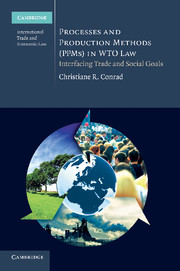Book contents
- Frontmatter
- Contents
- List of figures and tables
- Preface and acknowledgements
- Table of GATT 1947 Reports
- Table of WTO Reports
- List of abbreviations
- Introduction
- I Foundations: the relevance of NPA measures at the interface of domestic regulation, economic globalization and world trade law
- II Legal analysis: reviewing the status of NPA measures de lege lata
- III Outlook: new perspectives on the legal status of NPA measures
- Summary and concluding remarks
- Bibliography
- Index
Summary and concluding remarks
Published online by Cambridge University Press: 05 June 2011
- Frontmatter
- Contents
- List of figures and tables
- Preface and acknowledgements
- Table of GATT 1947 Reports
- Table of WTO Reports
- List of abbreviations
- Introduction
- I Foundations: the relevance of NPA measures at the interface of domestic regulation, economic globalization and world trade law
- II Legal analysis: reviewing the status of NPA measures de lege lata
- III Outlook: new perspectives on the legal status of NPA measures
- Summary and concluding remarks
- Bibliography
- Index
Summary
The question of whether NPA and PPM measures are permissible under WTO law is often understood as unveiling certain general views or beliefs held by ‘supporters’ and ‘opponents’ of these measures. This work shows that the question, if taken for what it is, is completely unsuited to splitting the WTO community into two opposing groups. NPA measures are neither per se good nor bad. A simple ‘yes’ or ‘no’ as a response to the PPM or NPA question in WTO law is flawed, since it misses the complexity of the problem.
Part I Foundations
A preliminary legal analysis, a review and cursory analysis of the relevant political and economic background constitute the starting point of the analysis and the development of a new regulatory perspective on the issue. The legal foundations consist in the main in a preliminary analysis of relevant case law and of the relevant provisions of the WTO Agreements in order to identify the legal key issues. It confirmed the utmost importance of the concept of ‘like products’, as used in several provisions in different WTO Agreements. It is the uncertainty on the relevant factors for the determination of ‘like products’, in particular, the relevance of non-physical aspects, which makes measures linked to such aspects an object of extensive legal research. In addition, the cursory analysis showed that a certain ‘extraterritorial reach’ inherent to NPA measures, as well as the unilaterality or multilaterality characterizing design and application, are considered crucial for justifiability under the general exceptions.
- Type
- Chapter
- Information
- Processes and Production Methods (PPMs) in WTO LawInterfacing Trade and Social Goals, pp. 485 - 493Publisher: Cambridge University PressPrint publication year: 2011



